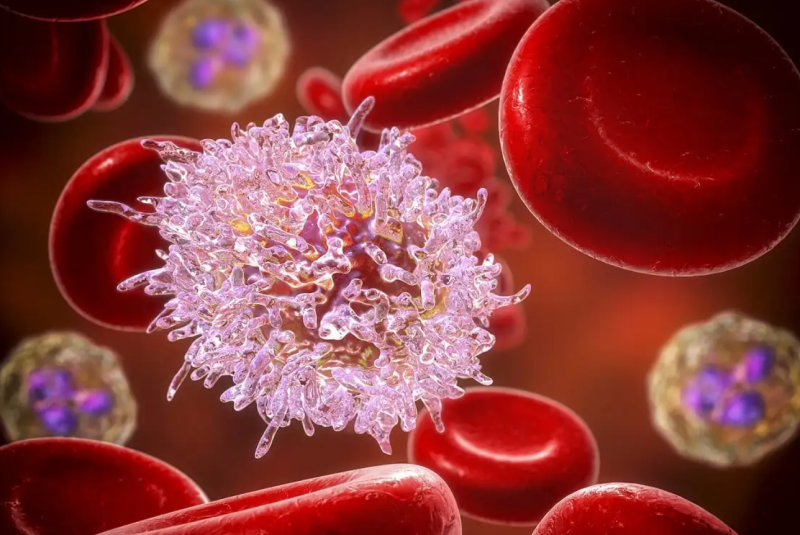
Knowing the symptoms of Leukemia enables a more timely diagnosis of the disease. Although the clinical manifestations vary depending on how it presents and how advanced it is, some general signs tend to be overlooked.
Leukemia is a cancer that occurs in the blood cells. It compromises the blood-forming tissues, such as the lymphatic system and bone marrow. In particular, it happens by a malignant transformation of hematopoietic stem cells, almost always white blood cells.
As it progresses, it interferes with the production of other blood cells, such as platelets and red blood cells, leading to severe complications such as anemia, bleeding, and increased risk of infections. Hence the importance of knowing how it presents itself to facilitate its detection and treatment.
Contents
The ten symptoms of Leukemia that you should not ignore
Leukemia has several classifications. It can be acute or chronic, depending on how fast it spreads, and myelocytic or lymphocytic, depending on the cell of origin. In turn, it is divided into several subtypes, such as the following:
- Acute myeloid Leukemia and chronic myeloid Leukemia, which compromises the myeloid lineage.
- Acute lymphoblastic Leukemia and chronic lymphocytic Leukemia, in which the lymphoid chain is affected.
- Others arise from mature white blood cells, such as mature B- and T-cell leukemias and NK cell-related leukemias.
The course and symptoms of Leukemia tend to vary depending on its origin. In general, some signs can be taken into account to arouse suspicion.

1. Purple or red spots on the skin
In medical terms, “petechiae” are reddish or purple spots that appear in clusters, usually on the chest, back, or arms. According to a review published via Seminars in Oncology, this may be caused by thrombocytopenia or coagulopathy.
Thrombocytopenia is a condition in which the blood platelet count is too low. Meanwhile, coagulopathy is caused by changes in the coagulation process. Both complications linked to Leukemia lead to rupture of the blood vessels, which leads to those little red colors.
2. Pain in the bones or joints
A survey conducted by Leukemia Care involving more than 2,300 patients revealed that bone and joint pain was a clinical manifestation of Leukemia before diagnosis. In particular, a sharp prick or dull pain is described, the intensity of which may vary depending on the affected area.
This source highlights that more than 60% of childhood leukemia cases manifest with bone and joint pain. Children often complain of ongoing pain in the legs or lower back.
3. Headache
Leukemia leads to decreased oxygen levels in the brain. Consequently, the surrounding arteries become inflamed, and a headache is generated.
A publication in Cancer Research UK explains that high white blood cell counts mean extra cells clogging blood vessels. Hence the passage of oxygen is limited.
4. Swollen glands
As the abnormal lymphocytes proliferate, their accumulation in the lymph nodes causes inflammation. This manifestation is more common in chronic lymphocytic Leukemia (96.4%) than in acute myeloid Leukemia (50%) and acute lymphocytic Leukemia (55.6%).
5. Weakness and tiredness
Weakness and tiredness are symptoms of a wide variety of diseases. In the case of Leukemia, it occurs due to decreased oxygen and nutrient transport due to low levels of healthy red blood cells.
A publication in Blood Cancer UK comments that, among other things, these signs of fatigue are caused by the effects of current or previous treatment, cancer itself, medications, and stress or depression.
6. Unusual bleeding
Unusual bleeding in Leukemia occurs due to decreased platelet counts. This situation interferes with the blood coagulation process, increasing bleeding susceptibility.
It is possible to experience profuse nosebleeds, bleeding gums (gingivitis), and abnormal uterine bleeding. Likewise, when sharing a skin injury, it will bleed excessively, and it will take longer to heal.
7. Frequent fevers and infections
Any form of Leukemia decreases the immune system’s ability to respond against pathogens that cause infections. For this reason, patients experience continuous episodes of fever and underlying conditions.
However, as research in the British Journal of Cancer exposes, fever can be accompanied by profuse sweating, predominantly at night.
8. Unexplained weight loss
The alarming and unexplained weight loss that occurs in Leukemia is due to the growth of malignant cells. They consume large amounts of energy that, in a healthy body, would be stored as fat. Also, people often experience a decreased appetite, affecting their weight.9. Shortness of breath
A study in the British Journal of General Practice states that shortness of breath or difficulty breathing is a symptom that occurs in Leukemia, especially in acute myeloid. It happens because cells require more oxygen than they can receive due to interference in blood flow.
Leukemia can also cause a small gland in the chest called the thymus gland to enlarge. This is located just in front of the trachea, so its inflammation can compress this structure and cause respiratory distress.
10. Abdominal pain and digestive problems
The abdominal pain in Leukemia usually occurs due to an enlarged spleen (splenomegaly). This occurs when malignant cells increase in and around this organ, leading to inflammation.
To a lesser extent, this pain is due to enlargement of the liver (hepatomegaly), which occurs due to the infiltration of leukemic cells, the development of viral hepatitis, or due to drugs.
A study published in the Journal of Gastroenterology and Hepatology details that, in addition to abdominal pain, patients with this cancer may experience other digestive symptoms, such as the following:
- Diarrhea.
- Nausea and vomiting.
- Abdominal distension.
- Ulcers.

An early consultation improves the prognosis.
The presence of these symptoms should be a reason for medical consultation. It should be remembered that they do not always obey Leukemia and may be the manifestation of other health disorders.
However, the diagnosis must be confirmed in the laboratory through blood tests, physical examinations, and bone marrow analysis. Timely detection is critical to accessing treatment and improving the prognosis.